Read about and see the excavations as they are uncovered.
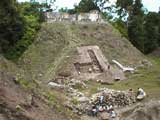
A3 with A2 in the foreground.
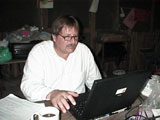
Computers invaded
Caracol this year.
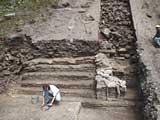
A3, steps, mask and
Sandra in the foreground.
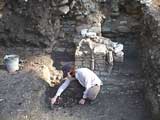
A3’s central mask element
and once agian, Sandra.
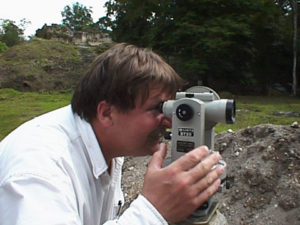
Arlen surveys the situation.
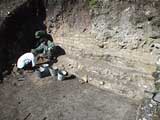
A2, North side of the stair.
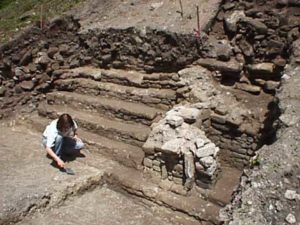
Is that Laundra?
Structure A3 (Sandra and Chris with Rudel):
The lower western side of the frontal stair for the building (Sub Operation C12F) has been largely exposed above the floor level. The lower stairs are in good shape and we thought we had the edge of the stair, but it appears to have been cut through or collapsed in antiquity. Given the nice even edge of the remaining stair, it is possible that what collapsed was a balustrade rather than the stair itself. Small pieces of carved slate were found in the humus level of this excavation, but there are no indications of a full carved monument. The humus has also been cleared off of the Str. A3 (C12G) axial trench and the stone rubble has been exposed. There are no steps visible – all of the steps above the mask appear to have collapsed forward. Removal of this axial rubble has begun in search of any buried architecture.
Structure A2 (Lana, Joel, Stephanie, and Tanya with Carlos and Ramon):
Excavation to the north of the front stair (Sub Operation C71G) has located the lower basal terrace of the pyramid for Structure A2, as well as the northern side of the projecting front stair for the building substructure and several plaster floors. The basal terrace exhibits architectural elaboration in the form of an inset panel that is itself inset again into the platform face and bordered as well by an eastern plinth. Excavations at the base of the stair (Sub Operation C71I) confirmed our suspicions that the (latest) stair was in a bad state of disrepair; it is not preserved at all beyond the first two steps (which are actually out of place, having been pushed forward by the pressure exerted in the collapse of a 25 meter high pyramid). Amy is working on the section drawing; Stephanie has started a plan of the plaza floors and the basal architecture. Clearing of the basal axial trench (C71H) was begun with the humus being removed to expose the fallen stones in the collapse level. A fragment of carved slate was found during this clearing.
Structure A1 (Lana, Tanya, Joel, and Ramon):
Excavations were re-opened to the south (on the back-side) of Structure A1 just west of the tomb encountered during the 1997 field season. This is a continuation of last year’s Sub Operation C141I, which had located the rear basal terrace of Structure A1. Within a short time of expanding this excavation, a well preserved architectural outset was found; this outset projects to the south and runs west, is about 50 cm in height, and has a square corner. Investigations are exposing this outset and the associated floor in hopes of locating the exterior facing that would have concealed the tomb to the west. The excavation has also found the outlines of Linton Satterthwaite’s cut through the floor that was made in 1951 to remove an intact stela and altar from this area.
Structure A10 (Angel and Dolly):
Excavations were initiated at the southern base on this structure with an axial 2 meter by 2 meter frontal test (SubOperation C150B) designed to find the lower steps for the building. The collapse within this excavation has almost entirely been cleared, resulting in the discovery of two crudely constructed steps and an associated floor.
Survey (Scott, James, and Tim with Gustavo, Rolando, and Luis)
The survey crew has nearly completed mapping a 500 meter wide transect for a distance of 1.3 kilometers to the north of the Puchituk terminus. This area has extremely steep terrain, which means that there are less housemound groups, but more terraces. Only the housemound groups are being recorded.
Lab (Amy and Neil as well as the rest of the crew):
Only 2 buckets of sherds are left to be numbered from the previous year(s)’ backlog. Amy is current on this year’s processing. We have the computers set up for entry of this season’s lot and object cards. Neil is working on computer images for the web-site.
Camp:
Construction and repairs are complete (we think). The roofs on all the buildings survived the most recent rain (earlier repairs had proved to still have leaks). Repairs, however, kept escalating all last week – first, one beam needed to be replaced and, then, the next time I checked, the whole thatch roof on the workmen’s kitchen was being lifted and re-set. All attempts to keep Tequila (the Caracol horse) out of the kitchen and garbage all failed until yesterday, when Ramon made a “garbage corral.” It seems to keep Tequila out, but it is also making the garbage a bit more difficult to reach. Everyone seems to be settling into a camp routine and helping out with the various camp tasks, such as pumping water to the kitchens, changing butane tanks for the stove, and putting pinesol on the outhouse seats.